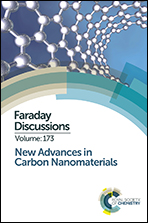Metal–semiconductor transition like behavior of naphthalene-doped single wall carbon nanotube bundles†
Abstract
Naphthalene (N) or naphthalene-derivative (ND) adsorption-treatment evidently varies the electrical conductivity of single wall carbon nanotube (SWCNT) bundles over a wide temperature range due to a charge–transfer interaction. The adsorption treatment of SWCNTs with dinitronaphthalene molecules enhances the electrical conductivity of the SWCNT bundles by 50 times. The temperature dependence of the electrical conductivity of N- or ND-adsorbed SWCNT bundles having a superlattice structure suggests metal–semiconductor transition like behavior near 260 K. The ND-adsorbed SWCNT gives a maximum in the logarithm of electrical conductivity vs. T−1 plot, which may occur after the change to a metallic state and be associated with a partial unravelling of the SWCNT bundle due to an evoked librational motion of the moieties of ND with elevation of the temperature.
- This article is part of the themed collection: New Advances in Carbon Nanomaterials

 Please wait while we load your content...
Please wait while we load your content...